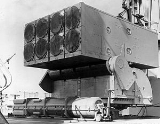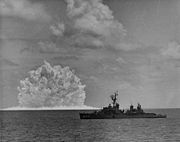
ASROC
Encyclopedia
ASROC is an all-weather, all sea-conditions anti-submarine missile system. Developed by the United States Navy
in the 1950s, it was deployed in the 1960s, updated in the 1990s, and eventually installed on over 200 USN surface ships, specifically cruisers, destroyer
s, and frigates. The ASROC has been deployed on scores of warships of many other navies, including Canada, Germany, Italy, Japan, the Republic of China, Greece, Pakistan and others.
by using sonar
and/or other sensors, it could relay the sub's position to an ASROC-equipped ship for attack. The attacking ship would then fire an ASROC missile carrying an acoustic homing torpedo
or a Nuclear Depth Bomb
(NDB) onto an unguided ballistic trajectory toward the target. At a pre-determined point on the missile's trajectory, the payload separates from the missile and deploys a parachute to permit splashdown and water entry at a low speed and with minimum detectable noise. The water entry activates the torpedo, which is guided by its own sonar system, and homes in on the target using either active sonar or passive sonar.
In cases where the ASROC missile carried an NDB, the unguided bomb would sink quickly to a predetermined depth where it would detonate. The nuclear-armed ASROC was never used beyond one or two tests in 1961-62. Eventually the Limited Nuclear Test Ban Treaty banning underwater nuclear tests went into effect. The nuclear weapon was never used in combat. An ASROC missile could hypothetically carry a 10 kiloton W44 nuclear warhead
, although the W44-armed nuclear weapons were retired by 1989, and all types of nuclear depth bombs were removed from deployment.
 The first ASROC system using the MK-112 "Matchbox" launcher, was developed in the 1950s and installed in the 1960s. This system was phased out in the 1990s and replaced with the RUM-139 Vertical Launch ASROC, or "VLA".
The first ASROC system using the MK-112 "Matchbox" launcher, was developed in the 1950s and installed in the 1960s. This system was phased out in the 1990s and replaced with the RUM-139 Vertical Launch ASROC, or "VLA".
s were all built in the shipyard with the Mark 16 Mod 7 ASROC Launching Group and MK 4 ASROC Weapons Handling System (AWHS) reload system. These had one standard Mark 112 octuple ASROC launcher, located immediately above a reload system holding an additional 16 assembled rounds (two complete reloads of eight missiles apiece). Thus, each Spruance-class destroyer originally carried a maximum total of 24 ASROC.
Most other U.S. Navy and allied navy destroyers, destroyer escorts, frigates, and several different classes of cruisers only carried the one ASROC 'matchbox' MK 112 launcher with eight ASROC missiles (although later in service, some of those missiles could be replaced by the Harpoon anti-ship missile). The "matchbox" Mk 112 launchers were capable of carrying a mixture of the two types. Reloads were carried in many classes, either on first level of the superstructure immediately abaft the launcher, or in a separate deckhouse just forward or abaft the Mk 112.
The MK 16 Launching Group also had configurations that supported HARPOON RGM-84 (Onboard Knox Class Destroyer Escorts (Fast Frigates)) or a variation of the Tartar missile in limited distribution.
Ships with the Mk 26 GMLS, and late marks of the Mk 10 GMLS aboard the "Belknap"-class
, could accommodate ASROC in these power-loaded launchers (the Mk 13 GMLS was not able to fire the weapon, as the launcher rail was too short).
Most Spruance-class destroyers were later modified to include the Mk 41 VLS
, these launchers are capable of carrying a mixture of the VL-ASROC, the Tomahawk TLAM, and other missiles. All of the Spruance destroyers carried two separate quad Harpoon launchers. Other US ships with the Mk 41 can also accommodate VL-ASROC.
 Italy
Italy
 Republic of China
Republic of China
United States Navy
The United States Navy is the naval warfare service branch of the United States Armed Forces and one of the seven uniformed services of the United States. The U.S. Navy is the largest in the world; its battle fleet tonnage is greater than that of the next 13 largest navies combined. The U.S...
in the 1950s, it was deployed in the 1960s, updated in the 1990s, and eventually installed on over 200 USN surface ships, specifically cruisers, destroyer
Destroyer
In naval terminology, a destroyer is a fast and maneuverable yet long-endurance warship intended to escort larger vessels in a fleet, convoy or battle group and defend them against smaller, powerful, short-range attackers. Destroyers, originally called torpedo-boat destroyers in 1892, evolved from...
s, and frigates. The ASROC has been deployed on scores of warships of many other navies, including Canada, Germany, Italy, Japan, the Republic of China, Greece, Pakistan and others.
Description
After a surface ship, patrol plane or anti-submarine helicopter detects an enemy submarineSubmarine
A submarine is a watercraft capable of independent operation below the surface of the water. It differs from a submersible, which has more limited underwater capability...
by using sonar
Sonar
Sonar is a technique that uses sound propagation to navigate, communicate with or detect other vessels...
and/or other sensors, it could relay the sub's position to an ASROC-equipped ship for attack. The attacking ship would then fire an ASROC missile carrying an acoustic homing torpedo
Torpedo
The modern torpedo is a self-propelled missile weapon with an explosive warhead, launched above or below the water surface, propelled underwater towards a target, and designed to detonate either on contact with it or in proximity to it.The term torpedo was originally employed for...
or a Nuclear Depth Bomb
Nuclear Depth Bomb
A Nuclear Depth Bomb is the nuclear equivalent of the conventional depth charge and can be used in Anti-Submarine Warfare for attacking submerged submarines...
(NDB) onto an unguided ballistic trajectory toward the target. At a pre-determined point on the missile's trajectory, the payload separates from the missile and deploys a parachute to permit splashdown and water entry at a low speed and with minimum detectable noise. The water entry activates the torpedo, which is guided by its own sonar system, and homes in on the target using either active sonar or passive sonar.
In cases where the ASROC missile carried an NDB, the unguided bomb would sink quickly to a predetermined depth where it would detonate. The nuclear-armed ASROC was never used beyond one or two tests in 1961-62. Eventually the Limited Nuclear Test Ban Treaty banning underwater nuclear tests went into effect. The nuclear weapon was never used in combat. An ASROC missile could hypothetically carry a 10 kiloton W44 nuclear warhead
W44
The W44 was an American nuclear warhead used on the ASROC tactical anti-submarine missile system.The W44 had basic dimensions of 13.75 inches diameter and 25.3 inches length, a weight of 170 pounds, and a yield of 10 kilotons....
, although the W44-armed nuclear weapons were retired by 1989, and all types of nuclear depth bombs were removed from deployment.

Specific Installations
The 31 U.S. Navy Spruance-class destroyerSpruance class destroyer
The Spruance-class destroyer was developed by the United States to replace a large number of World War II-built Allen M. Sumner- and Gearing-class destroyers, and was the primary destroyer built for the U.S. Navy during the 1970s....
s were all built in the shipyard with the Mark 16 Mod 7 ASROC Launching Group and MK 4 ASROC Weapons Handling System (AWHS) reload system. These had one standard Mark 112 octuple ASROC launcher, located immediately above a reload system holding an additional 16 assembled rounds (two complete reloads of eight missiles apiece). Thus, each Spruance-class destroyer originally carried a maximum total of 24 ASROC.
Most other U.S. Navy and allied navy destroyers, destroyer escorts, frigates, and several different classes of cruisers only carried the one ASROC 'matchbox' MK 112 launcher with eight ASROC missiles (although later in service, some of those missiles could be replaced by the Harpoon anti-ship missile). The "matchbox" Mk 112 launchers were capable of carrying a mixture of the two types. Reloads were carried in many classes, either on first level of the superstructure immediately abaft the launcher, or in a separate deckhouse just forward or abaft the Mk 112.
The MK 16 Launching Group also had configurations that supported HARPOON RGM-84 (Onboard Knox Class Destroyer Escorts (Fast Frigates)) or a variation of the Tartar missile in limited distribution.
Ships with the Mk 26 GMLS, and late marks of the Mk 10 GMLS aboard the "Belknap"-class
Belknap class cruiser
The Belknap class cruiser was a class of single-ended guided missile cruisers built for the United States Navy during the 1960s...
, could accommodate ASROC in these power-loaded launchers (the Mk 13 GMLS was not able to fire the weapon, as the launcher rail was too short).
Most Spruance-class destroyers were later modified to include the Mk 41 VLS
Mark 41 Vertical Launch System
The Mark 41 Vertical Launch System is a shipborne missle canister launching system which provides a rapid-fire launch capability against hostile threats. The Vertical Launch System concept was derived from work on the Aegis Combat System. Refinement of the concept continued through the 1960s and...
, these launchers are capable of carrying a mixture of the VL-ASROC, the Tomahawk TLAM, and other missiles. All of the Spruance destroyers carried two separate quad Harpoon launchers. Other US ships with the Mk 41 can also accommodate VL-ASROC.
Operators
 Italy
Italy Republic of China
Republic of ChinaSee also
- IkaraIkara (missile)The Ikara missile was an Australian ship-launched anti-submarine missile, named after an Australian Aboriginal word for "throwing stick". It launched an acoustic torpedo to a range of , allowing fast-reaction attacks against submarines at ranges that would otherwise require the launching ship to...
- Hong Sang Eo (Red Shark) rocket-based torpedo (K-ASROC)Hong Sang Eo (Red Shark) torpedoHong Sang Eo torpedo , also called the K-ASROC, is a vertically launched anti-submarine missile successively developed and tested by South Korea's University of Science and Technology, the Korea Agency for Defense Development and the Republic of Korea Navy in 2009...
- MalafonMalafonMalafon was a French ship-launched anti-submarine missile system. Developed in the 1950s and 60s, the weapon was intended to take advantage of the greater detection ranges possible with towed sonar arrays. The missile entered service in 1966 and was manufactured by Groupe LatécoèreThe weapon is...
- MILAS
- RUM-139 VL-ASROCRUM-139 VL-AsrocThe RUM-139 VL-ASROC is an anti-submarine missile in the ASROC family, currently built by the Lockheed Martin company for the U.S. Navy.The design and development of the missile began in 1983 when the Goodyear Aerospace company was contracted by the U.S. Navy to develop a ship-launched...
- Sea LanceSea LanceThe UUM-125 Sea Lance was authorized in 1980 as a successor to both the UUM-44 SUBROC and RUR-5 ASROC anti-submarine missiles. The Sea Lance was to be available in two versions, known as UUM-125A and RUM-125A...
- SUBROC
- TerascaTerascaTerasca, or Terrier-ASROC-Cajun, was an American three-stage sounding rocket developed and launched by the United States Navy. Derived from a combination of the Terrier, ASROC and Cajun rockets, three launches were attempted during 1959, but only one was successful.-Design and development:The...
External links
- http://www.fas.org/man/dod-101/sys/missile/vla.htm
- http://www.gyrodynehelicopters.com/asroc.htm
- http://designation-systems.net/dusrm/r-5.html

